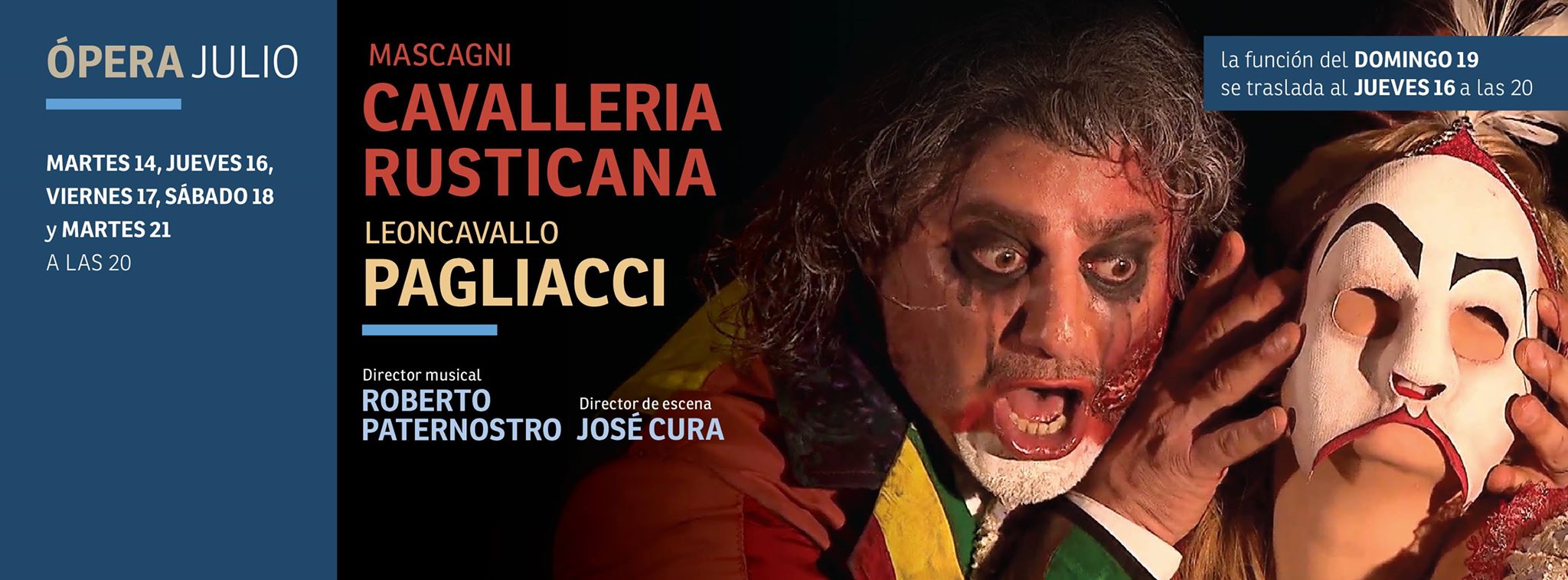
Bravo Cura
Celebrating José Cura--Singer, Conductor, Director
Operas: Cavalleria rusticana
Teatro Colón 2015

|
|
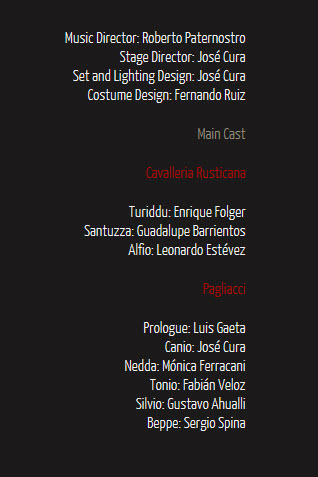 |
|
José Cura's Concept of Development See more on José Cura's Official Facebook Page // Click the image below.
|
|
Rehearsal
|
Cavalleria rusticana and Pagliacci @ Teatro Colón
|
|
|
1
|
.jpg) 2 |
.jpg) 3 |
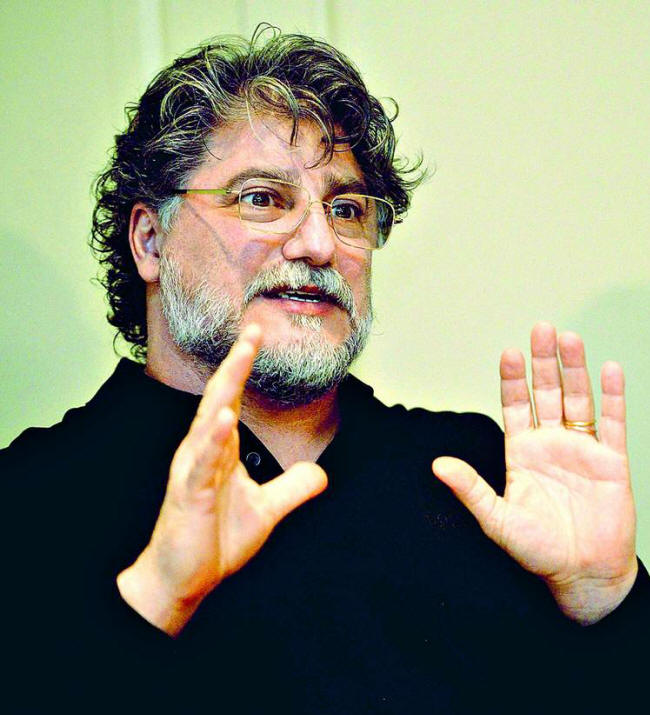 |
| Note: This is a machine-based translation. It is provided as a way to offer a general idea of the conversation and the ideas exchanged but should not be considered definitive
Caminito come to the opera with José Cura Clarin Sandra De La Fuente 13 July 2015
Interview. The great Argentinian tenor returns to the Colón with "Cavalleria Rusticana" and "Pagliacci". In this set, the action takes place in the passage of La Boca. “I do not feel comfortable doing young roles. I feel intellectually dishonest," argues the Santa Fe tenor, based in Madrid. José Cura has just begun chat with Ñ, in the dressing room that has been assigned in Colón. After presenting in 2013 his particular vision of Otello, Cura returns to Colón to present the most famous operatic duo: Cavalleria Rusticana and Pagliacci, the Verismo operas that seem made for him. As on that occasion, not only did he sing—he was Otello in his own production and now he will be Canio in Pagliacci - but he is also responsible for the mise en scène and program notes. And though his physical attitude—energetic--almost as if were on stage trying to hide it, his dark eyes reveal the fatigue accumulated in so many days of dealing with the usual technical problems, as well as leading a human group often particularly susceptible as singers . Your concern about the physique du role is unusual among the big names of opera, who struggle to leave certain roles even knowing that physical and voice calling them where else. Yes, well, I know, Pavarotti was Rodolfo, but one would listen to him, not to see Bohème. I feel uncomfortable about singing Turiddu. Because I keep noticing that I'm a 50 year old man who does not look good dealing with the dilemmas of a boy of 20. I do not feel an old, but my sound is dark, and even though I have learned to hide it when necessary, I think that concealment is not good for the character. I do not think I do any favors to the public in that costume. Let's talk a bit about the implementation of these two works. I know they will be located in the Caminito passage, the neighborhood of La Boca. Tell me the reasons that led you to choose that location. The reasons are obvious to us, but they were not at the Royal Opera de Wallonie, where this production premiered in 2012. Obviously, there is the issue of Italian immigration. It is that the Caminito is a perfect setting for the Verismo. And that was the idea that came to me when Horacio Sanguinetti invited me to produce this pair in that opera season that never materialized. I was just singing Pagliacci in San Diego in 2008 when Sanguinetti came to me and asked me to create a production duo. Then I thought it was an opportunity to design a tribute to Italian immigration of 1900s, I thought it would be ideal that all start to develop in the passage Caminito. So much so that the show begins with the voice of Gardel singing in the distance, his voice coming out of a radio. The success in Europe was absolute. Some critics wrote it was the best staging in the dramaturgical aspect that had been done in years. Then in 2010 I wrote a novella, Mamma Nunzia, which is the original name of Mamma Lucia. There I imagined the coexistence of all the characters in one place and time. That was the idea I used in Liege in 2012, with that set that had been stored without being used. For Many musicians and critics Cavalleria and Pagliacci are pure tuco, tremendous dramas, sentimental, without a really interesting storyline. Do you share this idea? Well, pasta with tomato and basil are just that but they are delicious and also you can eat them every day without the risk of developing clogged coronary arteries. I do not know if that would be a great program ... listen Cavalleria and Pagliacci every day. What I mean is that not everything simple is bad or disposable. God is simple because it is unique. The same applies to these works. The Verismo movement was born almost like an allergic reaction to all that wonderful rhetoric of Wagner and those characters too heroic that Verdi created. Verismo decided that describe characters of flesh and blood, people wrong, exposing their misery. This is what the Verismo movement claimed as a flag. That makes these operas appear to lack an intellectual engine. But I say "apparently" because, in fact, those who do not want to study very much are the ones who keep the external appearance and serves it as easy as it is not for nothing. One can keep the issue of noodles with tomato and basil are just pasta and not worry about seeing what it is that makes this dish something so great. From the musical point of view, the direct impact of these works is an achievement for you or you think they are easy to digest and not much else? Regardless of which one you like more or less the musical depth of these works, its characteristic is that the word is not in the service of music, what is said, the text is no longer an excuse for music. In Verismo the word is as important as the music. It is very easy to find the right time to sing Verismo that is precisely the time that one uses for the spoken word. One has to be able to say things without feeling pressured by the music. It is very different from the rest of the repertoire. I think of the name Tannhauser because I'm preparing it for 2017: Wagner's beauty is impressive but it is based on the musical rhetoric. Wagner approach requires an effort to understand what is happening musically. On the other hand, the musical approach to these parts [Verismo] is immediate. The great success they have had over time is also based on that. Of course, again, there is the risk that this immediacy is understood as vulgarity. And yes, these works have moments of vulgarity, but not because they are themselves vulgar but because the script asks for moments of vulgarity. An Example? In Pagliacci, Tonio asks for a kiss from Nedda, but only when he feels humiliated by her are you pulled over. She brings out a whip because he almost tries to rape her. This is a time of tremendous vulgarity but it is not intended, you cannot ignore, but it is important to understand the hatred of Tonio. You must know how to find balance in tone to tell the time. I hope people will like this set, especially because the project is very much ours. Is Caminito, there is a bandoneon, tango there is the voice of Gardel. I hope the audience will feel proud because it is one of the few times that so purely an Argentine landscape is used in a classic. Well, Marcelo Lombardero located many of his productions in Argentina. Without going any further, he did a Wozzeck at Villa 31. Oh, I spoke out of ignorance. I'm not so up to date with what occurs here. However, realism and Italian immigration in Caminito seems more than adequate. And the bandoneon, will sound or be like a folkloric element? It will sound clear. We will use in the intermezzo from Cavalleria. That moment is for strings and organ. The bandoneon is nothing more than a small, portable organ, so I thought that was very logical to introduce it in that environment.
|
Cavalleria rusticana at Teatro Colón
Direction / Staging / lighting by José Cura
|
|
.jpg) |
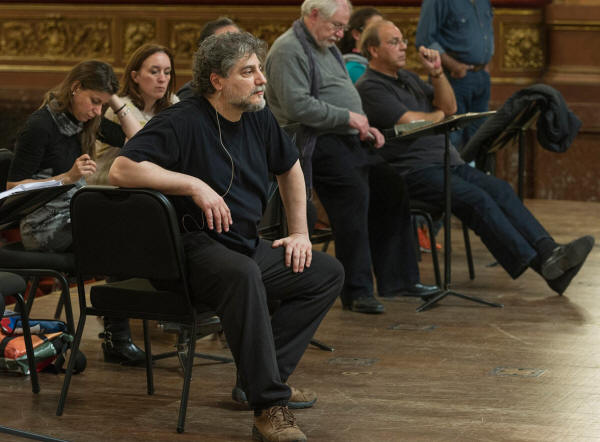 |
|
|
1
|
.jpg) 2 |
|
|
3
|
|
|
The production had been commissioned by Horacio Sanguinetti during his short time in the direction of Colón in 2008. "As soon as I heard the proposal, the neighborhood of La Boca appeared to me," says Cura, in his clear and powerful voice. "The enthusiasm was enormous and gave me reference for many ideas. To the point, that I wrote a novella, Mamma Nunzia, in 2010". As in 2013, when he made the production of Otello, Cura will be responsible not only the implementation (directing) but also for performing one of the main roles: he has chosen to play the clown Canio. And at the same time, he has also written extensive program notes. By putting so many items under your control, are you not afraid of losing critical perspective? Is it not also a gesture of distrust toward the public that you rushed to clarify concepts of your set in writing? No. If so, there would be no textbooks at all, nor would your interview by necessary. I believe in explaining to the public the motivations, then to discuss them or not, especially in such complex operas. Note that few know that Turiddu and Santuzza are diminutive of Salvatore and Santa. The original name of Turiddu’s mother is not Mamma Lucia, but Nunzia, which is, in turn, a diminutive of Annunziata, so it's Annunciation. Lola is short for Addolorata, sorrow in Spanish. And if that were not enough, the story of Cavalleria takes place on Easter: as such a Savior, the son of Annunciation, dies at Easter after being betrayed by Doloroso and sold by a Saint. And even more: the ceremony in which Salvador is delivered is a toast with red wine: a rite of blood. I had never read Cavalleria that way. Beyond the program notes, will there be clues in the staging that allow the audience to recognize it? There are clues, but music influences. That's a great fortune because it conveys mood and prepares the public;. but it is also tyranny, because it never stops. An actor can make the necessary pauses to convey the message, but the message in the music sometimes goes too fast. There are small details that I hope people see, but it can also happen what happened in Liege. What happened there? It happened that people came to several functions because they were felt there was more to discover. For example, the details of the toast, where Alfio is not like someone who comes out of nowhere and says, "Oh, they're all drinking wine." In my staging, Alfio, when he hears that there is commotion in the square that his balcony overlooks, looks out and Turiddu invites him down, invites him to provide; that is why it is that toast is a rite of blood. He is saying very quickly, with a gesture, "You and I know we have a problem and we need to fix it." The tradition of the people, which marks the title of the work, is that these problems are resolved with a duel. And the duel does not mean that the killer goes to jail, it has to be public, and that is understood as a duel of honor. These little clues are there, if you read them before. The reason I love this note is because it is a way of advancing what the audience sees. I always say we are professionals as well as artists and the audience for classical art in general should also be more "professional". Why? Because in classical art there is a great facade, but there is also the greatness that is all that can be found on it after several readings, that’s why it endures. You have to read, to learn.; I always remember the first time I was in front of the Mona Lisa and I thought yes, that was fine, but it was no big deal, until a friend explained to me the perspective, the stroke;. in short, all the things that appear in this work. And of course, I froze. And I looked with new eyes. It is more enjoyable when one investigates, when we study a bit. That difference is what makes the classic art what it is. What about Pagliacci? Did you also put a lot of thought in this work that appears so simple? Pagliacci is, indeed, much simpler. Cavalleria needs more explanation. Otherwise, people stay with a Mexican telenovela afternoon: he arrived, she tucked her husband horns, he became angry and killed the lover. Pagliacci is more direct: a spade is a spade is a spade. [the bread is bread, the wine is wine.] Can you describe it a little better? It is the drama of a failed comedian who drinks and is a bit violent, and this violence affects all his company, which is also violent. His wife, who never ceases to be a girl, suffers. Not for lack of love-because she was welcome and cared for-but, in any case, for lack of tenderness. But what happens there is quite normal, it does not require a deep analysis to understand, although it does to develop them. And the Caminito windows let me explain some things better. Although here you do not have to go back to Greek tragedy. |
|
|
.jpg) |
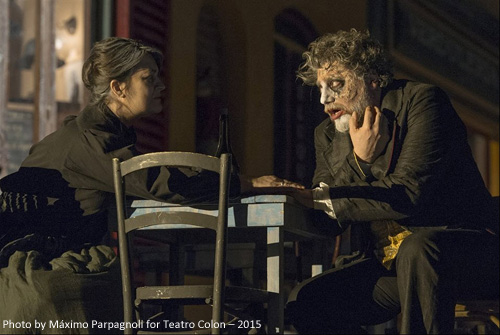 |
|
|
.jpg) |
|
Note: This is a machine-based translation. It is provided as a way to offer a general idea of the review but should not be considered definitive
La Boca, Operatic TerritoryLa Nación Pablo Kohan 16 July 2015
Cavalleria rusticana and Pagliacci / with: Enrique Folger (Turiddu), Guadalupe Barrientos (Santuzza), Leonardo Estévez (Alfio), Anabella Carnevali (Mamma Lucia) and Mariana Rewerski (Lola); José Cura (Canio), Mónica Ferracani (Nedda), Fabian Veloz (Tonio), Gustavo Ahualli (Silvio) and Sergio Spina / Regie, scenography and lighting: José Cura / Orchestra and Choir of the Teatro Colon / General Director: Roberto Paternostro / Teatro Colón / Our opinion: Very good Cavalleria rusticana and pagliacci / with: Enrique Folger (Turiddu), Guadalupe Barrientos (Santuzza), Leonardo Estévez (Alfio), Anabella Carnevali (Mamma Lucia) and Mariana Rewerski (Lola); José Cura (Canio), Mónica Ferracani (Nedda), Fabian Veloz (Tonio), Gustavo Ahualli (Silvio) and Sergio Spina / Regie, scenography and lighting: José Cura / Orchestra and stable choir and choir of the Teatro Colon / general Directorate: Roberto Paternostro / Teatro Colón / our opinion: very good. It was known that José Cura had decided to adapt Cavalleria rusticana and Pagliacci to transfer them from Sicily and Calabria to La Boca as a tribute to Italian immigration. But more significant than the geographical and temporal translation of these famous lyrics sisters who are not twins, much less twin, also involved, in his concept, the meeting of both in one continuous show, transforming each of them in an act of a diptych which had a logical sequence. In the same space, the passageway Caminito, first happens Cavalleria rusticana and, five months later, Pagliacci. But not only that. The characters and the consequences of Mascagni's opera reverberate and manifest within the drama of Leoncavallo. That entails some freedoms that go beyond a particular setting and the creative use of the stage area but other types of licenses, for example, rather than Tonio stating "La commedia è finita" Pagliacci in closing it is Mamma Lucia over the body of Silvio, whom she had taken almost as a surrogate son after the death of Turiddu. Generally speaking, adaptations of time and space that are subjected to these lawful (and necessary) opera searches the director applies to give them a new meaning or another scope, involve some contradictions that can generate coarseness or awkwardness. The actual or symbolic cultural landscape of a Sicilian or Calabrian town in the 19th century is not the same as the Buenos Aires neighborhood of La Boca at the beginning of the last century. However, we insist, these are minor details if the general theatrical ideas have sustenance and rationality. And Cura has them and uses them assuming all risks. In the beginning, before the symphonic sounds of Mascagni sounds, Gardel's voice is heard singing the emblematic and portenisimo tango of Filiberto. There is no contradiction. It is just an introduction to scents and colors of a specific place. Much more daring, on the other hand, is the double line of the violins with a bandoneon in the beautiful Cavalleria intermezzo while a couple - Lola and Turiddu - dance a tragic tango under the light of a lantern, a scene that can generate doubts about its relevance or timing. Finally, a different touch. When first opera is completed, the curtain is not closed nor is there a return to full theatre lights. In semi-darkened, as the audiences chooses to stay or leave, in the center of the stage - that is, in the Centre of Caminito - Juan Kujta, with all his fine sensitivity, reels off tangos and milongas with his bandoneon. The linkage between two operas by José Cura is derived from the physical appearance in Pagliacci the characters of Cavalleria... At the beginning, a procession carries the coffin containing the remains of Turiddu; five months later, Santuzza walks around in an advanced pregnancy, Mamma Lucia keeps attending in their canteen, and Lola has become a woman brutalized by her husband, Alfio. In the same place, life has continued and the inhabitants, in short, are the same. Those who are not the same are singers and, in this sense, they are much more fortunate in the second cast of the first. In Cavalleria, only Guadalupe Barrientos achieves a level of undisputed excellence. Her misfortunes, which are, in short, the cause of all the misfortunes, are fully realized in her voice and acting presence. Around her, on another level, only she offered correctness. On the other hand, the three main characters of Pagliacci had very good precision. Fabian Veloz was a great presenter, then a repulsive Tonio and, finally, a clownish clown, always very good. Mónica Ferracani highlighted both the birds aria and in her representation of Colombinas. And José Cura, multiple stellar performer of the night artist, showed all his vocal flow, his expressiveness and musicality in the construction of a perverse, hurt, macho and final Canio. The Coro Estable, the Coro de Niños and the Orquesta Estable were precise under the excellent direction of Roberto Paternostro, who accompanied with ductility throughout, respecting the times of each singer. The audience, in the end, seemed somewhat cautious when it came time to say thanks for so much effort and so much dedication. Perhaps it was these very original and well carried out theatrical ideas that slowed the enthusiasm. In any case, the most outstanding singers were showered with applause and cheers. |
|
|
|
|
.jpg) |
|
Bene Nota The Truth Will Set You Free!
|
|
Cavalleria rusticana and Pagliacci at the Colón
El Apasionado 19 July 2015 [Excerpts] Cavalleria rusticana - Opera in one act with by Pietro Mascagni and Giavani Targioni-Tozzetti. Cast: Enrique Folger (Turiddu), Guadalupe Barrientos (Santuzza), Leonardo Estévez (Alfio), Mariana Rewerski (Lola), Anabella Carnevali (Mamma Lucia). Pagliacci – A prologue and opera in two acts by Ruggero Leoncavallo. Cast: José Cura (Canio), Mónica Ferracani (Nedda), Fabián Veloz (Prólogo, Tonio), Sergio Spina (Beppe), Gustavo Ahualli (Silvio). Production of the Opera of Wallonia, Liege. Musical direction of Roberto Paternostro; direction, staging and lighting of José Cura; costumes for Fernando Ruiz. Orchestra, Coro Estable y Coro de Niños del Teatro Colón . The production of the operas Cavalleria rusticana and Pagliacci as planned by José Cura was very intelligent, full of details, with good acting treatment, joining the two operas as if they are a single one. The bandoneonist who stayed in the interval playing his tangos, the man who sits smoking off to one side, the waiter arranging the tables, the sign “five months later,” the funeral procession of Turiddu and the silent dialogue between Lola and Alfio at the start of Pagliacci and many other signs sought to unite the two Verismo works as if they were one. Moreover, and no less important, was that he placed them in the Caminito in La Boca. This choice, although it places the action in Buenos Aires, does not overlook that it is a choice that can be understood by anyone, from anywhere. Because La Boca, Caminito, is a place entirely dedicated to tourism and it would not surprise me if 90% of the people who visit are foreign tourists. That is to say, it was an identity of Buenos Aires but it is now a place of interest by tourists. Anyway, by the time of the operas Caminito was a place with a strong identity with Buenos Aires. We can say, as a corollary, the Cura did very well, the production was a success, beyond a strange boo or two from noisy people who must have something against the tenor or against the theater or against both, who knows. These two works have been together forever but are, in my humble opinion, radically different. In my view, Mascagni was a very delicate, intelligent, fine musician who created works that deserve to be heard, and not just Cavalleria. But this opera is the best of him, in the beautiful melodies, the treatment of the choir, the dazzling arias, not just for the background music as but in the drama part of it. The work of Leoncavallo, on the other hand, is full of gimmicky moments, much of the music is part of the drama, which is not a bad thing, just that it is what makes Mascagni superior. There are subtle differences in the arguments. The drama of Cavalleria is complex, the story is one that comes from afar, with much weight; the characters are complex, their relationships are complicated, they do what they do even though they know it is wrong because they have a history behind them, different motivations, and because they are driven by their innermost feelings: primarily led by love but also by jealousy, resentment, the desire for revenge. In addition, the customs of the people of the time play a very important role. In contrast the drama of Pagliacci is direct—an unrequited love, an evil betrayal, and jealousy do the rest and all is rushed. In Cavalleria the folkloric scenes predominate the middle of the drama, which is triggered slowly and inexorably, and the duel goes happens off-stage. In Pagliacci, the dominant scenes are brutally violent, sometimes rude, as when Tonio attempts to kiss Nedda and which is the root of the story. The production Enrique Folger was Turiddu and Guadalupe Barrientos performed the role of Santuzza in Cavalleria rusticana. Both did very well and even though it was announced that Guadalupe was suffering from a sore throat, so fashionable this winter, it was not noticeable. Both are well qualified actors and in this, our greatest theater, where it is so difficult to stand out […] Their voices were almost perfect, showing both great breath control and volume and with enough drama without neglecting the singing. Leonardo Estévez made an almost compadrito Alfio, with great poise and stage presence and a consistent, polished, perfectly audible voice. He perhaps lacked somewhat in his show of rage but he was fine. Anabella Carnevali as Mamma Lucia did not stand out much, her voice wasn’t bad but in this performance she seemed cold, while the brief role of Mariana Rewerski as Lola perfectly fulfilled the physique du rôle. The director arranged everything with extreme accuracy, the climate of Caminito in the early nineteenth century, the interaction between people, the marking of the actors, all was fine. As for the music, Maestro Pasternostro and the Orchestra of Teatro Colon again showed that they are able to perform well. What I didn’t like (I have the suspicion that this was the brainchild of Cura) was the bandoneon, which rang out during the famous Intermezzo, one of the most famous numbers of all time. I had hoped to enjoy it as it deserved and instead I spent two minutes looking for where that awful sound that had nothing at all to do with the original score was. When I discovered the bandoneonist onstage (he later delighted us with some tangoes in between the operas, I must say), I was disappointed. But, hey, surely someone liked it. Pagliacci showed us a cruel drama with excellent performances by José Cura as Canio, Mónica Ferracani as Nedda and Fabian Veloz as Tonio. All three are real monsters onstage, their voices were sparkling, very prominent and credible performances. Then it was Gustavo Ahualli in the role of Silvio, which showed ductility and strength in his singing and offered a good performance, although the bar waiter outfit did not favor him up on stage. A great work. Sergio Spina took the role of Beppe. Spina is special for these supporting roles …Here the scene was also very well treated, the characters moved very unwrapped and they staged the most violent scenes in a convincing manner. I had the impression that Paternostro was more comfortable in this work. In short, a homogenous production of Cavalleria rusticana and Pagliacci, very intelligent, with many important details, others not so much, and a few perhaps not desirable, but it worked. A sight to see.
|
|
|
|
|
Rough Translation: "In 2013, it was a meeting between old friends. In 2015, it was a meeting between brothers. Let's see what we do next time. A hug to all, José Cura"
|
|
|
60 years later ... Mundo Clasico Eduardo Benarroch 31 July 2015 [Except] José Cura needs no introduction, except to let the reader know of the breath of the activities of this artist. He has long mixed his activities as a singer with that of composer, stage director, and orchestra conductor. It is silly to think this is favoritism, for any artist who is elected by the Prague Symphony Orchestra as resident artist must be taken seriously.
Cura imposes an indigenous
Konzdept by placing
the action in the neighborhood of La Boca, the first
point of contact in the great Italian immigration in the
late nineteenth and early twentieth centuries. Many
of these Italians came not from the North but from the
poorest parts, namely the South. And the first thing
you see when the curtains open is a faithful
reproduction of the corner of Caminito, where Lola lives
in that narrow little apartment and where, when her
husband is away, she continues her relationship with her
great love: Turiddu. Momma Lucia owns the café / bar,
under the apartment, and it is there on the
square (which actually exists) the action in
Pagliacci will develop. Cura has always been an interesting singer. I remember him well from his early beginnings in the Royal Opera House in London, in the first version of Simon Baccanegra, directed by that master among masters, Mark Elder. But that clarion voice soon went on to sing heavier roles and he came to sing a very meritorious Otello. His Samson was also outstanding. There are many examples of singers who enter years when they no longer sing well, Cura will be no exception, but it is interesting that he has the note, and he has them all; what should be noted is how he reaches those notes, which is not always musical. But it is his immense stage presence which produces the greatest effect and it was here that he won his battle all night, because he delivered and because he is an intelligent artist. His two productions moved well, his ideas were clear and well executed. Enrique Folger, a tenor I did not know, sang and acted correctly in the difficult and thankless part of Turiddu. Guadalupe Barrientos, with a voice that is perhaps too lightweight for Santuzza, exuded dramatic force on the stage, winning the sympathy of much of the audience. Leonardo Estevez has a sexy voice, but light for Alfio, Marina Rewerski sexuality was personified as Lola, while Anabella Carnevalli showed a good understanding of the role of Mamma Lucia. The Prologue raised the level of singing with another I did not know, Fabian Veloz, a baritone of great voice, beautiful traditional color which brought to mind listening to a singer of the old school with elegant phrasing and the roundness of voice. His Tonio had the necessary dose of villain and frustrated, playful, but dangerous man. Veloz is a good actor and with his great voice it isn’t hard to foretell a very good career for him. Mónica Ferracani personified a mature, insecure, attractive Nedda. ..
The Choir sang with great sound, impressing the listener
with the clarity and musicality against a conductor who
should never have been chosen to direct the show. The
sounds emanating from the pit were crude, pathetic,
poorly coordinated without phrasing, too fast in tempi,
messy and defenseless, and a succession of notes that
never said anything valid. Take as an example Nedda’s
beautiful aria 'Stridono lassù,'
full of lightness and sexuality, a woman who evokes
birds with which to fly away from her oppressive,
tyrannical husband. The orchestra plays with the words,
requires sweetness, innocence, and above all
flexibility. It’s like the same flying of the birds.
Paternostro’s reading seemed more like a heavy vulture
hovering over the corpse of the score. Perhaps the
first violin would have given better results from the
podium. It has been many years since I have heard so
little from a musical director. |
|
|
|
|
|
|
|
|
|
|
|
|
||||
|
|
.jpg)
|
|||
|
||||
Last Updated: Sunday, February 05, 2023 © Copyright:
Kira